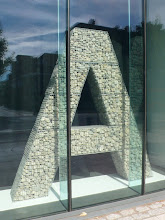I began to take simple rubbings of things that I caught my eye as I explored the city. This process retains a sense of connection between the hand, the paper and the stone. Had I photographed these sites there would have been a physical separation—a barrier between person and place negating our multi-sensory experience of the world.
Many of the images recorded are of traditional materials, but others are more contemporary. The more I walked, the more I saw, the more I touched. This haptic journey is retold through the pages of a small book. If you click on the photos below, you will get an enlarged image, but then you will need to hit the back button on your browser to get back to the rest of this post.

The cover is made with P180 fine grade sandpaper, thus giving the book itself a rough, stone-like quality when touched. The final rubbing is of the seat I sat on at Waverley station as I waited for the train to take me back to London.

The book is perhaps not particularly interesting from a design point of view, but what was interesting for me was the method and approach. It is, in a sense, work deriving from a 'gut instinct' of Edinburgh. There was no in depth research, no interviews, no exploration of a wider context.

It was an immediate response to my surroundings and my experience of them. Perhaps this could be said to be exploring my phenomenological take on the place? This is not how I usually work—I normally prefer to tell richer, more peopled, stories of place; to work with more content and to develop more complex narratives.

However, these are built over time, and often with participants, but I was in Edinburgh for one week only, so I had to improvise and explore other ways of working. It was a nice change to develop something so quickly and in such a short space of time—unlike the ongoing PhD.

Perhaps it will enable me to look afresh at the work I am doing in Hackney, or the ways I am working generally. After all, my physical encounter with Edinburgh is inevitably no more subjective than any other representation of place by anyone else, and therefore just as valid in its own small way.


No comments:
Post a Comment